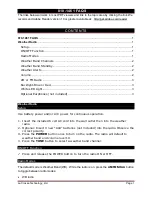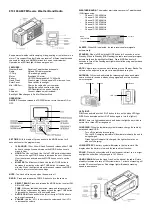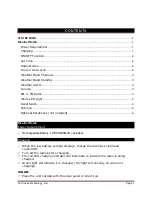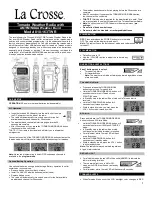
3
⑦
Top Button
Programmable function button: Press it to activate the
programmable auxiliary function.
⑧
Microphone/Speaker Jacks
For connecting the optional Microphone/Speaker.
Chapter 3 Electrocircuit
3.1 Frequency Configuration
Figure 3.3 Frequency Configuration
This radio adopts the 2nd Mixer, the 1st IF 51.65MHz, the 2nd IF
450kHz.
The receiver's first local oscillation is generated by the frequency
synthesizer. The second local oscillation adopts the 4th harmonic
51.2MHZ of TCXO.
The transmitter signals are generated by frequency synthesizer.
The reference frequency of frequency synthesizer is generated by
TCXO.
3.2 Receiver (RX)
Figure 3.4 Receiver (RX)
The Receiver Front Terminal
Signals from the antenna pass through the RX/TX switch (D102,
D103, D104); and then undesirable out-of-band signals will be
filtered out at the band pass filter (BPF) consisting of C260, L756,
L732, C259, C750,C731,D700,C730,L212,C256
,
C257
,
D210
,
C255
,
L211
,
C253
,
and D209; then signals are amplified at the
low noise amplifier (LNA) consisting of Q26 and its peripheral
components.
The output from the LNA passes the BPF consisting of L207
,
L206
,
L720
,
C248
,
C702
,
D207
,
C245
,
C244
,
and C733 for
filtering and then is sent to the first grade frequency mixer (Q21).
The First Frequency Mixer
After mixing the receiving signals from LNA with the first local
oscillation signals from the frequency synthesizer, the 1st IF signals
(
51.65MHz
)
are generated. The first IF signals pass the crystal
filter (XF203), which will filter the signals of adjacent channel and
those out of band.
IF Circuit
The 1st IF signals from the crystal filter are amplified at the first IF
amplifier (Q204), and then are sent to the IF processing IC (IC204,
TA31136FN).
The IF IC consists of the 2nd frequency mixer, the 2nd local
oscillator, IF amplifier, limiter, phase frequency detector, and noise
amplifier.
After amplifying TCXO (X301), the 4th harmonic 51.2MHz is made
as the signal source of the 2nd local oscillation. The 2nd oscillation
signal
(
51.2MHz
)
and the 1st IF signal
(
51.65MHz
)
are mixed at
IC204 to generate 2nd IF
(
450kHz
)
. After the 2nd IF signal is
amplified and its amplitude is limited at IC204, and then filtered at
porcelain filter (wide band CF201/ narrow band CF202
,
450kHz),
IC204 demodulates and sends out audio signals.
Figure 3.5 IF System
Receiver Audio Signal Processing
IC404
,
IC405
,
IC407
,
and IC408 and their peripheral circuit
compose the receiver audio signal processing circuit. IC204 sends
audio signals to IC404 for amplification, and then one route goes to
IC405 (CTCSS signaling filtering circuit) for waveform shaping and
then to IC6-D; one route goes to IC408 where the signals are
amplified, de-emphasized, filtered and the HF (high frequency) and
LF (low frequency) will be eliminated, and then for the remaining
300-3000Hz audio, one route is sent to volume potentiometer for
adjustment and finally sent to the audio amplifier (IC401), and the
other one route passes IC407 (2-Tone/5-Tone filter ) to MCU.
Figure 3.6 Receiver Audio Signal Processing
Squelch Circuit
Demodulation output from IC204 is sent to the selection frequency
noise amplifier, which consists of IC204 inner noise amplifier and
C121
,
R252
,
R211
,
C209
,
and R212 to be filtered off the noise.
After being amplified at Q205, noise is sent to D299 for wave
checking and then sent to MCU, which determines the noise
volume to control the squelch.
Audio Amplifier
IC401 and its peripheral components construct the BTL audio
amplifier.
Receiving audio signals, voice indication signals, indication tone
signals and warning tone signals are collected for audio
amplification to drive the speaker. Warning tone has no volume
PT5200 SERVICE MANUAL





































